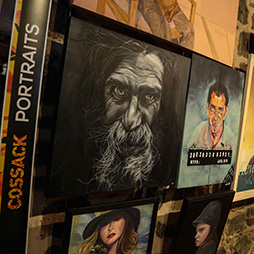 And the winner is...
And the winner is...
words by Annette Davis
This is the moment that the enthusiastic crowd has come to hear. This is the moment about which the artists in attendance are growing increasingly nervous. At any art award, the exhibition opening and the announcement of winners is an occasion full of anticipation and celebration. At the Cossack Art Awards, billed as regional Australia’s richest acquisitive art prize, the build-up is somehow accentuated by the transformation of the physical space we are in. The cavernous, and usually empty, historic Bond Store and its neighbouring Telegraph and Post Building have become sparkling galleries of art, buzzing with the excitement of the large crowd, 1600 km north of Perth.
The annual flood of artworks into Cossack started in the early 1990s, when Brian Hoey, the curator of the historic settlement, initiated an art award to bring life to the recently restored Bond Store. Artists in the Pilbara embraced the idea and by the late 1990s the Cossack Art Awards had grown in profile and prize money. Katherine Stafford, now of Gallows Gallery in Mosman Park, was instrumental in lifting the profile of the Art Awards during her years as coordinator. By 1999 entries had increased so much that more space was needed, and the old Post Office was put into service.
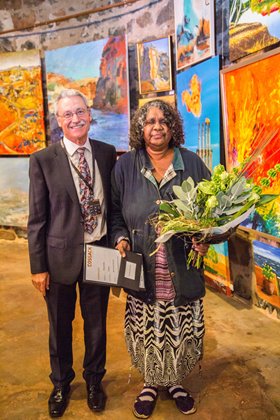 The Cossack Art Awards is now a major event presented by the City of Karratha (previously the Shire of Roebourne). The local government authority has always managed the receipt of entries, budget management and community events associated with the Awards. Wisely, it has contracted in coordinators with the skills to manage the exhibition installation, liaison with judges and each year’s selected artists who are specifically invited to participate. The coordinators have also arranged public programs of skills development in art handling and curation that run as part of the Awards. From 2011 to 2013 Artsource worked with Pilbara-based art consultants Archipelago Arts to deliver the event, and was contracted separately in 2014 to run workshops and manage the installation of the exhibition. Over this period the events offered as part of the annual program expanded to maximise the opportunities the Awards could bring to the community. Just one example is the popular Family Day, held on the first Sunday of the exhibition that attracted 3000 people this year.
The Cossack Art Awards is now a major event presented by the City of Karratha (previously the Shire of Roebourne). The local government authority has always managed the receipt of entries, budget management and community events associated with the Awards. Wisely, it has contracted in coordinators with the skills to manage the exhibition installation, liaison with judges and each year’s selected artists who are specifically invited to participate. The coordinators have also arranged public programs of skills development in art handling and curation that run as part of the Awards. From 2011 to 2013 Artsource worked with Pilbara-based art consultants Archipelago Arts to deliver the event, and was contracted separately in 2014 to run workshops and manage the installation of the exhibition. Over this period the events offered as part of the annual program expanded to maximise the opportunities the Awards could bring to the community. Just one example is the popular Family Day, held on the first Sunday of the exhibition that attracted 3000 people this year.
The striking historic buildings, though restored, continue to require repairs and maintenance. The installation of a new hanging system in the Bond Store in 2011 was a long overdue improvement, and an upgraded lighting rig is flagged for the future.
Each year, the organisers grapple with the inherent difficulties of turning an old unused building into a venue suitable for displaying hundreds of precious artworks.
Ongoing sponsorship from the major resources companies and other Pilbara businesses has meant that the Cossack Art Awards now offers prize money of $109,500 spread across 12 acquisitive awards, plus a People’s Choice Award. Two categories are exclusively for Pilbara artists, while two other categories have Pilbara or North West subject matter as their focus. The categories are occasionally modified to balance the number of entries within each category, an example being the amalgamation of the two categories for Indigenous artists into one category, Painting by a Pilbara Indigenous Artist, to shift the focus onto the highly acclaimed Indigenous artists that call the Pilbara home.
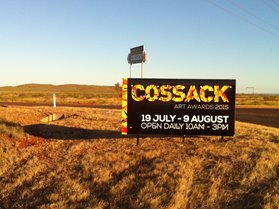 The Cossack Art Awards is an interesting example of how a visual arts event can be shaped to be much more than an exhibition with prize money.
The Cossack Art Awards is an interesting example of how a visual arts event can be shaped to be much more than an exhibition with prize money.
Responding to the interests of the community, together with the sponsors, Cossack Art Awards have evolved into a major event, or series of events, which encourages visitors to the region, develops and profiles local creative talent as well as positioning the Awards as worthy of the national prestige commensurate with the high prize money.
“The Cossack Art Awards is a hybrid,” explained Nancy Milligan, Events Co-ordinator for the City of Karratha. “It is recognised nationally as a prestigious art prize, and we have tried to develop this during the last twelve months. But at the same time it is a community exhibition. It is open to all.”
Steering this hybrid through the last Awards cycle was Catherine Czerw, the contracted curator for 2015. Catherine says, “The most unique thing about this Award is that it is non-selective.” She admits that her initial response was that the exhibition would be better with a selection process, given the quality of entries is so broad. However, by the end of the process this year she appreciated this characteristic, pointing out,
“The fact that it is non-selected gives it a quirky, very democratic, and refreshing, angle.”
Into this democratic exhibition, with artworks of varying quality hung by category across the walls of two historic buildings, enter the Art Awards’ judges. In the early years a single judge tackled the huge task of assessing and selecting for the numerous prizes. Ken Done, Betty Churcher, and Robert Juniper are just a few of the high profile individuals who took on this task. In more recent years, two judges have worked together, and it is intended to increase this to three in 2016. As well as a critical eye and generous nature, the judges bring credibility and profile to the Awards. For many of the judges, like this year’s judges, artist Vernon Ah Kee from Queensland, and Sydney-based art critic John McDonald, it is their first visit to the Pilbara, and the itinerary includes visits to some of the highlights of the region. A few months on from judging the 2015 Awards, the experience remains vivid for John McDonald, who says, “There is no art prize anywhere like the Cossack Art Awards. The extreme democracy of the selection, in which entries are chosen on a first-come basis makes it a wildly eclectic affair, but it still manages to produce work of quality.” Describing the old Bond Store as, “…one of the more atmospheric places to hang a show,” McDonald says, “what was perhaps most impressive was the reaction of the public, when huge crowds converged on this isolated spot for the opening day. Although I’ve judged many art prizes over the years, the Cossack remains one of the most memorable.”
Ask any artist why they don’t enter an art prize and a major reason is the cost of freight. To overcome this obstacle, the organisers have an arrangement with a reputable art transport company to provide return freight from Perth for $55. This certainly encourages participation by WA artists, and though the return freight rates are naturally higher from Sydney, Melbourne and Brisbane (between $247 and $300), some artists from these States are still attracted to enter (10% in 2015).
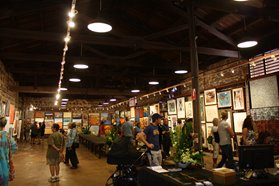 Of the 314 entries in 2015, 86% were from Western Australia and 41% were from the Pilbara. The ‘invited artist’ category, introduced in 2001, intended to broaden the range of art on display and to bring the work of established artists to the Pilbara audience, has continued with varying effectiveness. As a strategy to increase the national profile of the Awards, two artists from each state and territory were invited to take part in 2015 and although their entry fee was waived, they still needed to cover the freight costs to Cossack, with return freight covered by the City of Karratha if they didn’t sell. Having evaluated the efforts made over the last twelve months to achieve a stronger national profile, including advertising in major printed and online arts publications, the City of Karratha has recently decided that it will refocus on activities that strengthen the Awards’ place in the local community.
Of the 314 entries in 2015, 86% were from Western Australia and 41% were from the Pilbara. The ‘invited artist’ category, introduced in 2001, intended to broaden the range of art on display and to bring the work of established artists to the Pilbara audience, has continued with varying effectiveness. As a strategy to increase the national profile of the Awards, two artists from each state and territory were invited to take part in 2015 and although their entry fee was waived, they still needed to cover the freight costs to Cossack, with return freight covered by the City of Karratha if they didn’t sell. Having evaluated the efforts made over the last twelve months to achieve a stronger national profile, including advertising in major printed and online arts publications, the City of Karratha has recently decided that it will refocus on activities that strengthen the Awards’ place in the local community.
For local artists, this is much more than an annual exhibition opportunity. It is also a time to learn from art professionals. Workshops leading up to the Awards encourage the involvement of emerging artists, and Artsource’s 6 x 6 talks, featuring local artists, both inspire and reaffirm artists whose art practice is more established. A panel discussion between the judges and the curator plus two artist talks extend the educational and professional development for attendees. Art handling, care and installation skills are also taught to volunteers and City of Karratha staff, including an Art Awards intern, thus passing on important art industry skills. The transitory nature of the local population means that the people benefitting from these skills may have moved on by the time of the next Awards, necessitating ongoing training in the lead up to the event.
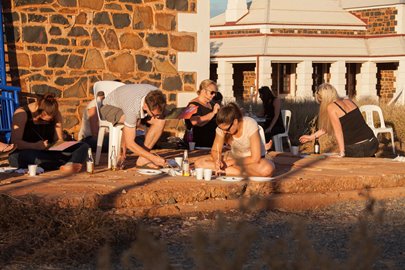 Awards categories for Pilbara based artists and Western Australian indigenous artists feed directly into the local community, providing particular opportunities for members of the two local indigenous art groups – Yinjaa-Barni Art Centre and Roebourne Art Group (RAG). “The artists start painting for the Cossack Art Awards at the beginning of the year,” commented Patricia Floyd, Manager of Yinjaa-Barni Art Centre. “The exhibition is a special time for the artists and being part of it gives them a lot of pride. Exhibiting and winning at this major regional event has earned them recognition as artists.”
Awards categories for Pilbara based artists and Western Australian indigenous artists feed directly into the local community, providing particular opportunities for members of the two local indigenous art groups – Yinjaa-Barni Art Centre and Roebourne Art Group (RAG). “The artists start painting for the Cossack Art Awards at the beginning of the year,” commented Patricia Floyd, Manager of Yinjaa-Barni Art Centre. “The exhibition is a special time for the artists and being part of it gives them a lot of pride. Exhibiting and winning at this major regional event has earned them recognition as artists.”
Artists from Yinjaa-Barni regularly win the category prizes and, as happened this year, the overall prize. Wendy Darby won the major $15,000 City of Karratha acquisitive prize with her painting Country, along with Barngi Pansy Sambo who won the ‘Painting by an Indigenous Artist’ category.
Over 20 artists from the Roebourne Art Group enter the Award. “The artists look forward to it. It is an event at which they can present their art and tell their story. It is awesome,“ says Loreen Samson from RAG. “It is also an opportunity to learn about art, about different styles of art, for the artists and for the judges.”
The two way opportunities also apply to local non-Indigenous artists. “For an emerging artist in the Pilbara, seeing your work next to the work of established artists can only be a good thing, as an opportunity to learn and be exposed to a range of art styles and techniques,” says Conseulo Cavaniglia, who worked on four Awards in her capacity as an Artsource coordinator.
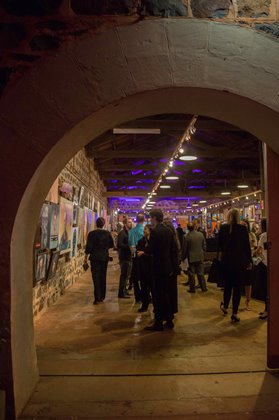 The decision to keep the focus on building the profile locally will also strengthen recent efforts to broaden the audience for the Art Awards. Along with the successful Family Day that includes entertainment, arts and crafts activities and food stalls organisers have trialled a live music event, an Indigenous showcase, a film night, mums and bubs story time, seniors morning tea and a schools program with students bussed from Karratha and Roebourne to the exhibition. These have all increased the involvement of the local population. Art workshops covering portraiture, workshops for youth and a ‘Beers and Brushes’ landscape workshop have all been booked out, signalling a desire in the community for practical technique-focussed tuition.
The decision to keep the focus on building the profile locally will also strengthen recent efforts to broaden the audience for the Art Awards. Along with the successful Family Day that includes entertainment, arts and crafts activities and food stalls organisers have trialled a live music event, an Indigenous showcase, a film night, mums and bubs story time, seniors morning tea and a schools program with students bussed from Karratha and Roebourne to the exhibition. These have all increased the involvement of the local population. Art workshops covering portraiture, workshops for youth and a ‘Beers and Brushes’ landscape workshop have all been booked out, signalling a desire in the community for practical technique-focussed tuition.
These activities build the Awards’ relevance locally. The City of Karratha continues to fine tune and extend its positioning of the Awards, conscious that its ongoing success relies on strong support from the local community – artists, art lovers and, most importantly, those who didn’t realise that an art exhibition could be so much fun.
So the winner is…? The hope of the organisers of the Cossack Art Awards is everyone who visits or participates in this remote art event.
Annette Davis is an artist and freelance curator. During the past two decades she has managed arts projects in Perth, Kununurra, Karratha and Albany, where she currently lives.